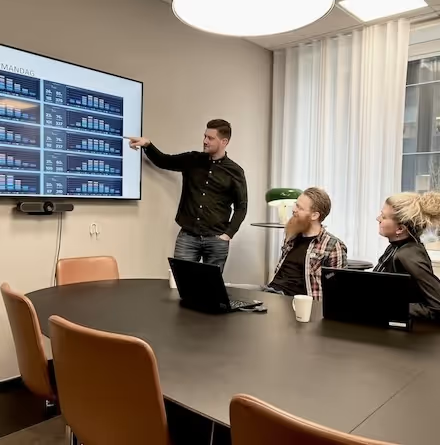Customer CASE STUDY

How DEAS uses data to make better decisions in its space planning
.avif)
DEAS Group, a leading real estate specialist and advisor in the Nordics, has been using data since 2020 to gain insights into how to design even better spaces for users of its buildings.
"In the past, we would create interior plans based on how we thought they would work. Now, we are able to not only gather data on how our space planning functions but also continuously change and optimise it," explains Mie Møller, Lead Architect for Space Planning at DEAS Group.
Mie continuously assesses and analyses the latest data on the utilisation of square meters with colleagues Martin Hansen and Mathias Kæmmer from the Energy Management & Data Department.
.avif)

From expansion plans to optimisation of existing spaces
A project that DEAS is currently working on is Flintholm Company House in Copenhagen, owned by pension fund PKA. The tenant expressed a desire for more meeting rooms, but instead of adding more square footage, DEAS started collecting data on how each room was utilized.
After a short period of data collection, DEAS realised that it wasn't a matter of needing square footage but rather a matter of optimising the existing space.
Specifically, through their data, DEAS and Mie Møller demonstrated that there were specific days when meeting rooms were used more frequently than others and that the rooms farthest from employees' workstations were rarely utilised.
The data showed that:
Between 8-16, the meeting rooms were booked 28% of the time.
On average, there were 4 ½ persons in each room (with a room capacity of 10).
There is a correlation between the size of the room and the utilisation rate.
The meeting rooms are most frequently used on Tuesdays and Thursdays.
Utilising spaces outside peak hours
.avif)
DEAS doesn't only use data to make better decisions regarding space utilisation but also creates more inspiring environments for employees. This is where the concept of "smarter square footage" comes into play.
"After Covid, remote work became the norm, and we were faced with the challenge of how to create an attractive office that would entice employees to come in and work," explains Mie Møller.
For most companies, it is typical that common areas, such as the cafeteria, are only utilised during peak hours. However, how can so many vacant spaces be used outside peak hours as well?
"We analyse our current layout. Can we redesign the cafeteria in a way that encourages informal meetings, for example?" she continues.




